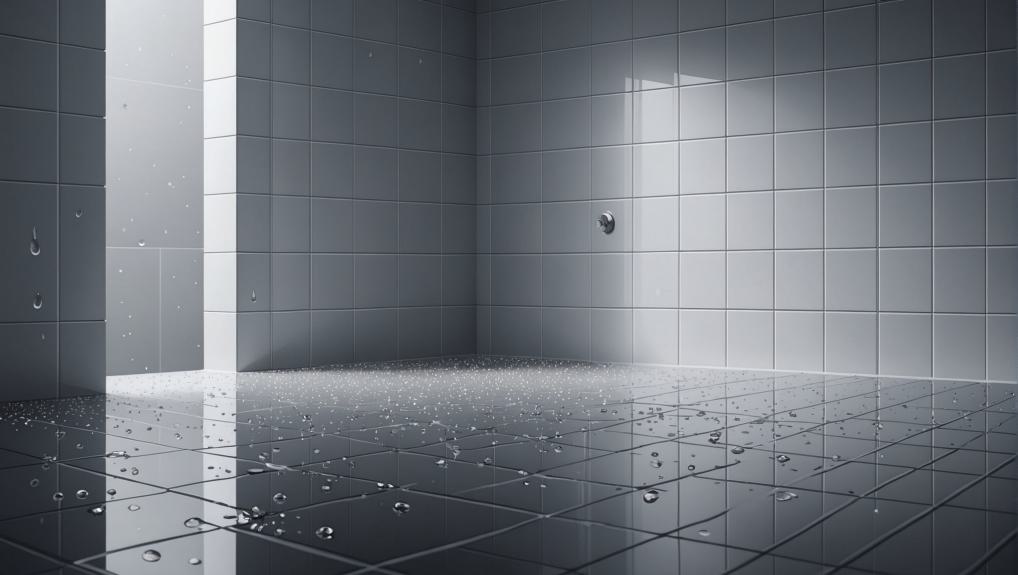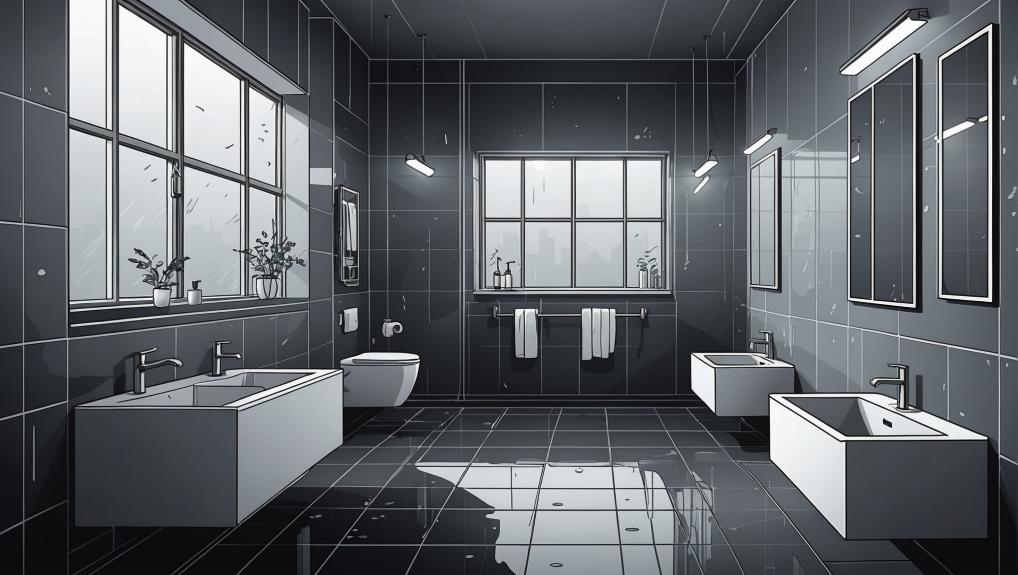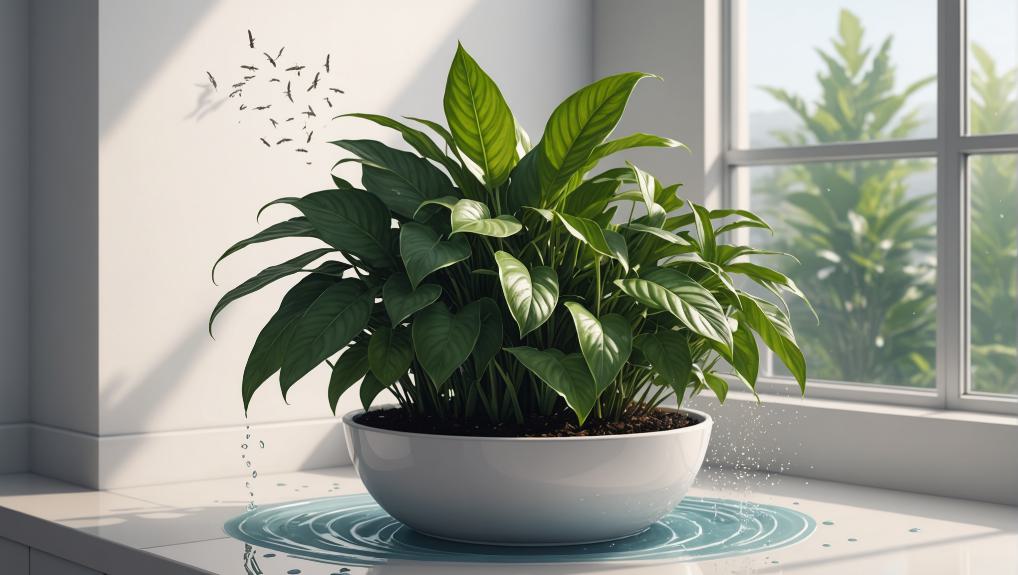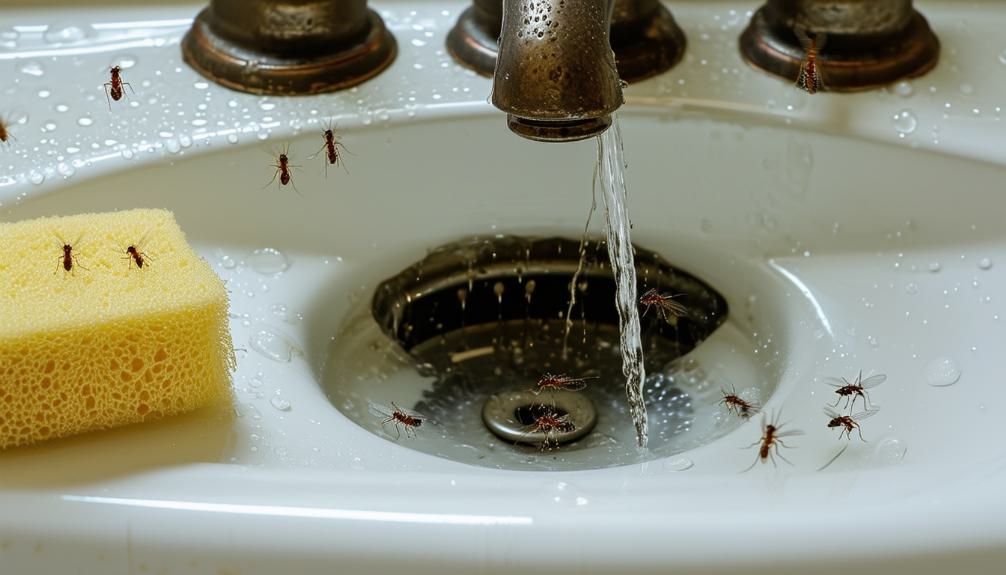Gnats in the bathroom often result from high moisture levels due to daily activities like showering Dealing with gnats in the bathroom can be frustrating and perplexing. These tiny pests seem to appear out of nowhere, disrupting your space and peace.
In this article, we will uncover the common causes of gnats in your bathroom. We’ll explore why they are drawn to this environment and what factors contribute to their presence.
By understanding these causes, you can take effective steps to eliminate and prevent gnats, ensuring a clean and gnat-free bathroom.
Key Takeaways
- High moisture levels in bathrooms attract gnats, especially in poorly ventilated spaces.
- Accumulated organic matter like hair and soap scum provides breeding grounds for gnats.
- Poor ventilation traps moisture, increasing the likelihood of gnat infestations.
- Clogged drains and leaky pipes create ideal conditions for gnats to thrive.
Moisture and Humidity

Gnats thrive in the moist and humid conditions often found in our bathrooms. Activities like showering, using sinks, or flushing toilets introduce water, significantly increasing moisture levels.
Humidity levels above 50% are particularly inviting to gnats, as they flourish in damp environments. Without proper ventilation, steam from showers lingers, creating an ideal habitat for these pests.
Stagnant water is another significant attractant. Leaks, clogged drains, and poorly ventilated areas all contribute to higher moisture levels.
Even small amounts of standing water can draw gnats. It’s crucial to regularly inspect and repair leaks, ensure drains are clear, and maintain good ventilation. Neglecting these measures can quickly turn our bathrooms into a gnat hotspot.
Regular cleaning and maintenance are key to controlling moisture levels and preventing gnat infestations.
Wiping down surfaces, using exhaust fans, and keeping the space dry are all proactive steps. By managing moisture, we can reduce the likelihood of sharing our bathrooms with these unwelcome guests.
Organic Matter Accumulation
Gnats infest bathrooms due to the accumulation of organic matter such as hair, soap scum, and skin cells. These materials can gather in drains and sink areas, creating prime breeding grounds. As organic matter decays in the moist bathroom environment, it attracts gnats, especially fungus gnats, that thrive on decomposing material.
Even small amounts of organic waste can lead to significant problems. Gnats are drawn to decaying organic matter, and bathrooms provide plenty of it if not properly cleaned. Hair trapped in drains, soap scum on tiles, and skin cells on surfaces all contribute to a gnat-friendly environment.
Regular and thorough cleaning is essential to prevent infestations. Hidden spaces, like beneath sinks or behind toilets, often harbor organic debris missed during routine cleaning. Ensuring the removal of these accumulations can significantly reduce the likelihood of gnats breeding in bathrooms.
A small effort in cleaning can make a big difference in keeping these pesky insects away.
Poor Ventilation

Poor ventilation in bathrooms creates a humid environment ideal for gnat infestations. When airflow is insufficient, steam from showers gets trapped, causing moisture to accumulate on surfaces and in corners.
This dampness attracts gnats and other moisture-loving pests. Studies indicate high humidity levels can increase gnat infestations by up to 50%.
To combat this, install exhaust fans or open windows during and after showers. These simple actions help reduce moisture levels. Using bathroom fans or dehumidifiers keeps humidity below 50%, making it harder for gnats to thrive. Maintaining a dry environment is key.
Proper ventilation is crucial in preventing gnats. By taking proactive steps, you can enjoy a gnat-free bathroom. Ensure your bathroom has the airflow it needs to stay fresh.
Drain and Pipe Issues
Clogged drains and leaky pipes in bathrooms often create ideal conditions for gnats to breed. When drains are clogged, organic matter like hair and soap scum gets trapped, providing food for gnat larvae. This buildup, along with standing water, makes drains an optimal spot for gnats to lay eggs.
Leaky pipes worsen the issue by creating damp environments that attract gnats. Increased moisture, particularly in hidden areas under sinks, encourages these pests. Standing water, whether in a clogged drain or pooled under a sink, offers gnats the wet conditions they need to multiply.
Preventing gnat infestations requires regular maintenance and cleaning of drains and pipes. Removing organic buildup eliminates potential breeding sites and food sources for larvae. Ensuring pipes are leak-free reduces excess moisture, making bathrooms less inviting to gnats.
Regular maintenance helps keep bathrooms gnat-free and maintains overall hygiene. Simple actions, like using drain cleaners and checking for leaks, can keep these pests at bay.
Overwatered Plants

Overwatering houseplants can quickly turn soil into a breeding ground for gnats. When soil stays consistently moist, it creates an ideal environment for fungus gnats to thrive and reproduce. The larvae of these gnats feed on the organic matter in damp soil, leading to rapid population growth if overwatering continues.
To prevent this, let the top layer of soil dry out between waterings. This practice can greatly reduce the chances of a gnat infestation. Look for signs of overwatered plants, such as yellowing leaves or mold on the soil surface, as these indicate potential breeding grounds for gnats.
Proper drainage and careful monitoring of watering schedules are essential steps in preventing overwatering. Ensure plants have adequate drainage and water them only when necessary.
Overwatering isn’t just harmful to plant health; it also invites gnats into living spaces. Maintain a balanced watering routine to keep plants healthy and homes gnat-free.
Frequently Asked Questions
Can Gnats in the Bathroom Affect My Health?
Yes, gnats in the bathroom can affect your health. They can trigger allergies and indicate unsanitary conditions, which might lead to respiratory issues. Keeping a clean, dry environment is essential to maintain a gnat-free and healthy bathroom. Regularly cleaning surfaces, fixing leaks, and ensuring proper ventilation can deter these pests and improve overall hygiene.
How Do I Identify Different Types of Gnats?
To identify different types of gnats, observe their distinct features. Fungus gnats are dark and slender. Drain flies appear fuzzy and moth-like. Fruit flies are tan with red eyes. Phorid flies have a humpbacked appearance.
Conclusion
Gnats in the bathroom typically result from high moisture levels, organic matter buildup, poor ventilation, or issues with drains and pipes.
To prevent these pests, manage humidity, eliminate organic debris, ensure proper airflow, and maintain plumbing.
Keeping the bathroom clean and dry reduces gnat attraction. Regularly inspect for leaks and avoid overwatering plants.
These steps will ensure a more comfortable and hygienic bathroom environment.

